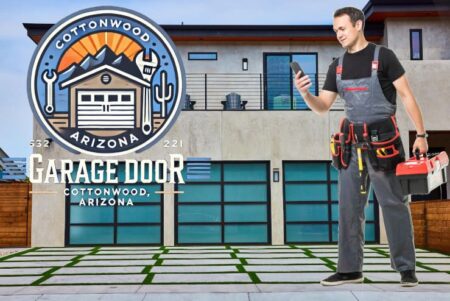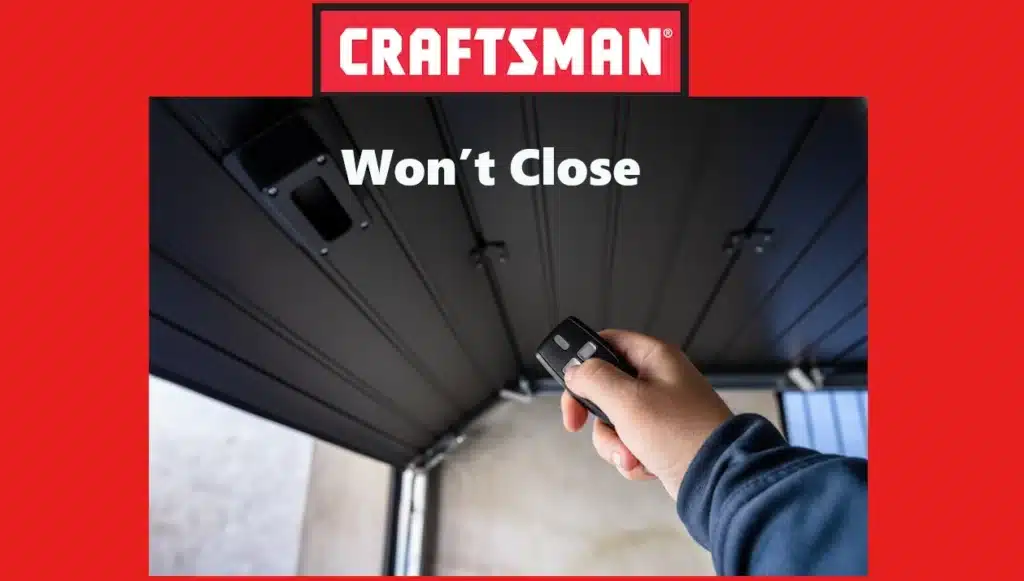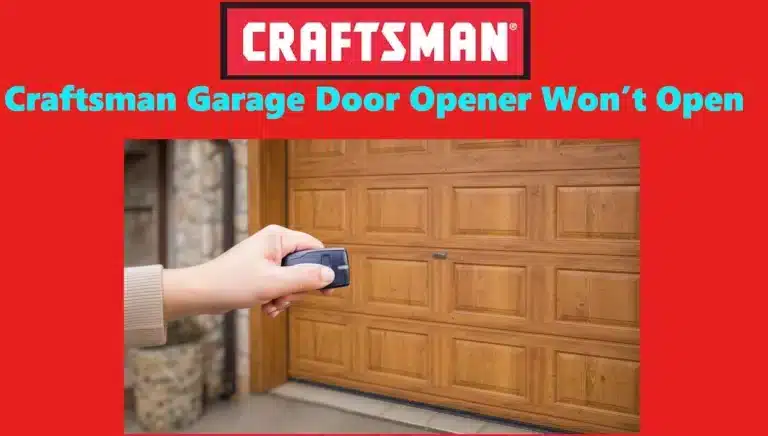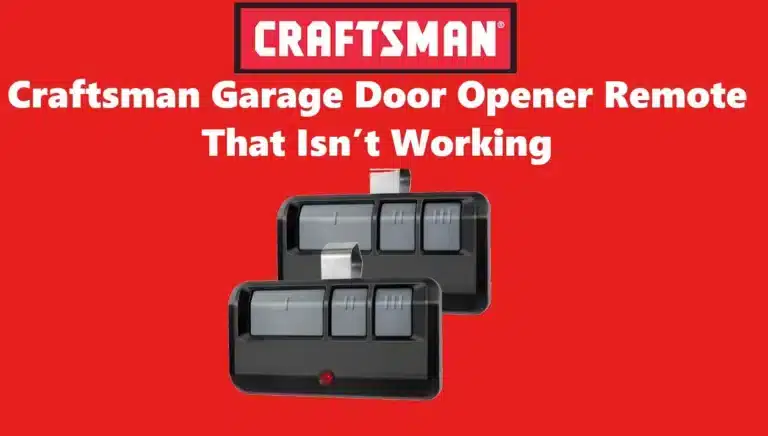Craftsman Garage Door Opener Won’t Close is the phrase that no homeowner wants to search for. Craftsman openers are part of the Chamberlain/LiftMaster family of products and are known for reliability, yet like any mechanical system they can refuse to close at the most inconvenient moment. Instead of forcing the door down or overriding the safety systems, it’s important to troubleshoot the underlying cause. The most common culprits are dirty or misaligned photo‑eye safety sensors, physical obstructions or track problems, improper travel or force adjustments, or accidentally enabled lock settings on the wall console.
This step‑by‑step guide explains how Craftsman openers work, how to methodically diagnose why your door won’t close, and how to get it working again. The guide draws on manufacturer manuals, professional repair services and industry experts to provide safe, accurate instructions.
Step 1 – Check the remote control and wall console
Many “won’t close” problems aren’t caused by the door itself but by the control devices.
1.1 Confirm the wall console isn’t in lock mode
Modern Craftsman wall consoles include a lock or vacation button that disables remote signals for security. Creative Door Services notes that when the lock feature is activated, a blinking LED on the wall button indicates that remote controls are disabled. To deactivate it, press and hold the lock button on the wall console until the LED stops blinking. BDK Door Company similarly advises holding the lock button for about 10 seconds or pressing it again until you hear a click.
1.2 Replace remote batteries and re‑test
Dead batteries are the most common cause of non‑responsive remotes. Replace the battery (usually a 3‑volt coin cell) and test. If the wall button works but the remote doesn’t, hold the remote near the motor unit and try again; if it still doesn’t close, proceed to reprogramming.
1.3 Reprogram the remote
Remotes can lose their connection to the opener after power outages or battery changes. Creative Door’s guide suggests pressing the Learn button on the opener until the indicator light turns on, then pressing the remote button within 30 seconds to re‑pair. For older Craftsman units, holding the Learn button for six seconds erases all codes; after erasing, press and release the Learn button, then press the remote button to program.
1.4 Check for signal interference
LED light bulbs, Wi‑Fi routers and other electronics can interfere with remote range. Ensure the opener’s antenna hangs straight down and move other devices away from the opener. If you must park within a metre of the opener for the remote to work, consider replacing LED bulbs in the opener or relocating the router.
Step 2 – Inspect the photo‑eye safety sensors
Blocked or misaligned photo‑eyes are the leading reason a Craftsman garage door opener won’t close. The sensors are required by safety codes and must be maintained. Sears Home Services explains that blinking opener lights indicate the safety sensors are blocked or out of alignment, and Express Garage Doors notes that the door will not close from the remote if the beam is blocked.
2.1 Remove obstructions and clean the lenses
Look for items such as ladders, bikes or trash cans that might interrupt the beam. Even a spider web or buildup of dirt can fool the sensor. Family Christian Doors points out that dust and debris can trick the system; wipe both lenses gently with a clean cloth. Express Garage Doors recommends clearing away cobwebs, leaves and debris around the sensors.
2.2 Check alignment and indicator lights
Each sensor has an LED light. Sears explains that the sending sensor has a yellow light that should always be lit, while the receiving sensor has a green light that glows steadily when properly aligned. If the green light is off or blinking, loosen the bracket bolts and align the sensors until both lights are solid. According to Express Garage Doors, the sensors should point directly at each other. Tighten the wing nuts to hold them in place once aligned.
2.3 Shield sensors from sunlight
Direct sunlight can overwhelm the infrared beam. Sears suggests installing sun shields if the opener closes properly at night but not during the day. You can also adjust the sensors slightly to reduce glare.
2.4 Check wiring and error codes
If neither sensor light is on, check the low‑voltage wires leading to them. Sears notes that one blink on the motor’s LED means disconnected wires and two blinks mean shorted wires. Repair any frayed wires and ensure the strands connect to the correct terminals (white to white, white/black to grey). Loose connections at the opener can also cause sensor errors.
2.5 Test the sensors at the motor unit
If alignment and wiring look good but the door still won’t close, Sears recommends testing the sensors directly at the motor. Disconnect the existing wires and connect the sending and receiving sensors to the opener using short jumper wires; if both LEDs light up and the door closes, the problem lies in the buried wiring. If one sensor fails to light, replace the sensors.
2.6 Don’t bypass the sensors
Never bypass or disable the photo‑eyes. Express Garage Doors warns that photo eyes are a vital safety feature; disabling them is dangerous and violates safety standards.
Step 3 – Look for physical obstructions and track issues
Even when the sensors are clear, physical problems with the door or its tracks can cause the opener to reverse.
3.1 Check the garage door tracks
Bent, dented or misaligned tracks create resistance that the opener interprets as hitting an obstruction. Family Christian Doors notes that even with aligned sensors, bent tracks can prevent the door from closing properly. Visually inspect both vertical and horizontal tracks; remove any debris and gently tap minor dents with a rubber mallet. Serious track damage or misalignment should be repaired by professionals.
3.2 Inspect rollers and hinges
Worn or damaged rollers can make the door jerk or stop mid‑travel. Spectrum Overhead Door’s guide recommends examining rollers and replacing any that are cracked or worn. Lubricate steel rollers and hinges with a light garage‑door lubricant—not grease—which attracts dust.
3.3 Remove objects blocking the door path
Make sure nothing is caught under the door, including gravel, toys or ice. The Craftsman manual advises clearing ice or snow from the garage floor where the door closes. Even a thick weather seal can make the opener think it’s hitting an obstruction; adjust the down limit if needed (see Step 5).
Step 4 – Review travel limit settings
If the door stops short of the floor and then reverses, the Down Travel limit may be set too low. Conversely, if the opener forces the door beyond the floor, the limit is set too high.
4.1 Identify the limit screws
On Craftsman chain‑drive models, the limit screws are usually located on the side of the opener’s motor housing. They are often labeled “Up” and “Down.” According to Aladdin Garage Doors, one full turn equals about 2 inches of travel. Use a flat‑head screwdriver to make adjustments.
4.2 Adjust the down travel limit
Run the door to see how far it travels. If it reverses before reaching the floor, turn the Down screw clockwise (increase travel) about a quarter‑turn. Test again, repeating with small adjustments until the door stops just at the floor. If the door slams into the floor or reverses after hitting the ground, turn the Down screw counter‑clockwise to shorten travel. The Craftsman manual cautions not to adjust limits so far that the trolley crashes into the stop bolt.
4.3 Adjust the up travel limit
If the door doesn’t open fully, turn the Up screw clockwise to extend travel; if it opens too far and hits the opener stop, turn it counter‑clockwise. Always test after each change.
Step 5 – Check and adjust force settings
Force controls determine how much resistance the opener senses before stopping or reversing. Misadjusted force can make the door refuse to close or cause it to slam shut dangerously.
5.1 Test the downward force
With the door halfway down, grasp the bottom edge with your hands. The door should reverse direction easily. If it is hard to hold or doesn’t reverse, decrease the Down (close) force by turning the force control counter‑clockwise. The Craftsman manual instructs making 10‑degree adjustments and running the opener through a full cycle after each change. Do not use force adjustments to compensate for a binding door.
5.2 Test the upward force
Similarly, with the door halfway up, hold the bottom edge. The door should stop when slight resistance is applied. If it continues upward, decrease the Up (open) force by turning the control counter‑clockwise. If the door does not open at least 5 feet, increase the Up force by turning the control clockwise.
5.3 Avoid excessive force
The manual warns against increasing force beyond the minimum required to close the door. Excessive force may hide serious mechanical issues and can be dangerous. If the door requires high force, check for track obstructions, worn springs or call a professional.
Step 6 – Test the safety reversal systems
The auto‑reverse feature should be tested monthly to ensure safety.
6.1 Test the photo‑eye auto‑reverse
Open the door fully. Place a cardboard box or a 2×4 flat on the floor in the door’s path. Press the remote; the door should move less than an inch before reversing, and the opener light should flash. Forest Door Company describes this test and notes that if the door continues to close or reverses late, the sensor or force settings need adjustment.
6.2 Test the mechanical force‑sensing reverse
Lay a one‑inch thick board (such as a 2×4 laid flat) under the door and close the door. The Craftsman manual instructs that the door must reverse upon striking the obstruction. If it does not, increase the Down travel limit slightly and retest. Repeat until the door reverses. If it still fails, call a professional—do not increase force excessively.
Step 7 – Examine door balance, springs and hardware
An opener should never be forced to lift an unbalanced or heavy door.
7.1 Test door balance
With the opener disengaged (pull the red emergency release cord), manually lift the door halfway. It should stay in place. If it falls or rises on its own, the springs may be worn or misadjusted. The Craftsman manual warns that garage doors, springs and cables are under extreme tension and can cause serious injury; spring repairs should be performed only by trained technicians.
7.2 Listen for unusual noises
Grinding or squeaking noises indicate worn rollers, hinges or gears. Spectrum Overhead Door lists loose hardware, lack of lubrication and worn drive gears as causes of unusual noises and recommends tightening hardware and lubricating moving parts.
Step 8 – Inspect wiring and electronics
8.1 Check sensor and wall control wiring
If the motor’s LED shows sensor error codes (one blink = disconnected wires; two blinks = shorted wires), inspect the wiring. Reconnect any loose wires at the opener or sensors and replace damaged wire. Family Christian Doors suggests inspecting wiring annually to prevent unexpected failures.
8.2 Look for logic board failures
Intermittent operation can indicate a failing logic board. Spectrum Overhead Door notes that if power and wiring aren’t the issue, the opener’s logic board may be bad. Because replacing a logic board requires expertise, schedule professional service.
8.3 Reset the opener
If all else fails, perform a reset. BDK Door Company suggests unplugging the opener or switching off the circuit breaker for 30 seconds, then restoring power. After resetting, test the remote and wall control; you may need to reprogram remotes (see Step 1).
Step 9 – Understand when to call a professional
DIY troubleshooting can fix many simple issues, but some problems demand professional help. Sears Home Services advises contacting a technician if the motor is unresponsive even though there is power, if the door slams shut or doesn’t stay open, if there are broken springs or frayed cables, or if there is excessive rust. Family Christian Doors recommends seeking professional diagnosis for persistent sensor, wiring or track issues.
Professional technicians have specialized tools to test sensors, measure force settings and safely adjust springs and cables. They can also replace stripped gears, worn belts or failing logic boards. If your door is large or heavy (wood, carriage‑house style) or you are uncomfortable with any adjustment, err on the side of safety and call a professional.
Preventive maintenance tips
Regular maintenance helps prevent future problems:
- Clean sensors monthly. Dust and debris accumulate quickly; wipe lenses with a microfiber cloth and ensure the LEDs glow solid. Shield sensors from sunlight if necessary.
- Test auto‑reverse every month. Perform both the photo‑eye test and mechanical force‑sensing test described in Step 6.
- Lubricate moving parts. Apply garage‑door lubricant to rollers, hinges and the opener’s chain or belt once or twice per year; avoid grease.
- Inspect wiring annually. Check sensor wires for rodent damage or wear.
- Check travel and force adjustments seasonally. Temperature changes can affect door movement, so minor adjustments may be needed.
Frequently Asked Questions
Why does my Craftsman garage door opener only close when I hold the wall button?
Holding the wall button overrides the photo‑eyes temporarily. This behavior usually means the sensors are blocked, dirty, misaligned or defective. Remove any obstructions, clean the lenses, verify that the green indicator light is on and realign as needed. If the lights won’t turn on, check wiring and error codes.
What indicates misaligned sensors on a Craftsman opener?
The receiving sensor’s green light should glow steadily when aligned. If it is off or blinking, the sensors need adjustment. The opener lights may blink 10 times when you attempt to close the door.
How do I deactivate the lock or vacation mode?
Press and hold the lock button on the wall console until the indicator light stops blinking. On some remotes, holding the lock button for 5–10 seconds also disables lock mode. Consult your user manual for specific instructions.
Can sunlight affect my safety sensors?
Yes. Direct sunlight can interfere with the infrared beam and prevent the door from closing. Sears recommends installing inexpensive sun shields or adjusting the sensors to reduce glare.
My remote worked yesterday but not today. What should I do? (full article)
First, replace the battery and test again. If the wall button works but the remote doesn’t, ensure the wall console isn’t locked. Reprogram the remote using the Learn button procedure. Check for interference from LED bulbs or electronics.
Why does the door reverse when it reaches the floor?
This usually means the Down travel limit is set too high or the door encounters resistance. Reduce the Down travel limit in small increments. Ensure the floor is clear of debris and the weather seal isn’t too thick.
What should I do if the opener motor hums but the door doesn’t move?
The Craftsman manual suggests that the garage door might be locked or the chain reinstalled incorrectly. Disengage any manual locks on the door and ensure the chain and trolley are properly engaged. A stripped gear inside the opener can also cause this problem; professional repair is recommended.
Is it safe to bypass or remove safety sensors?
No. Removing or bypassing the sensors violates safety codes and puts people and property at risk. Express Garage Doors stresses that the photo eyes are a vital safety feature and should never be disabled.
Why does my door reverse immediately after hitting the floor or before touching it?
If the door reverses before touching the floor, the Down travel limit may be too low. If it reverses immediately after hitting the floor, the Down force may be too sensitive. Adjust the limits and force controls in small increments and test using the obstruction test. An unbalanced or binding door may also cause premature reversal; examine tracks and springs and call a professional if necessary.
Conclusion
A Craftsman garage door opener that won’t close is frustrating, but it’s usually the result of a fixable issue. By understanding how the opener’s safety sensors, limits and force settings work, you can methodically diagnose the problem and address it safely. Begin with simple fixes such as deactivating the lock mode, replacing remote batteries and cleaning the photo‑eyes. Progress to checking track obstructions, adjusting travel and force settings, and testing the auto‑reverse system.
Remember the manufacturer’s warnings: never increase force to overcome a binding door and never bypass safety sensors. If your garage door still refuses to close or you encounter broken springs, cables or hardware, call a qualified professional. Regular maintenance—cleaning sensors, lubricating moving parts and testing reversal systems—will keep your Craftsman garage door opener operating smoothly for years to come.












